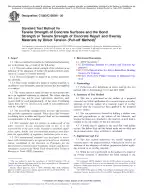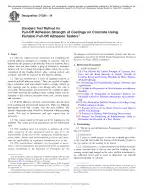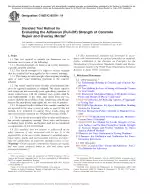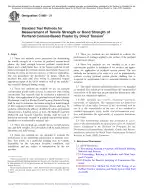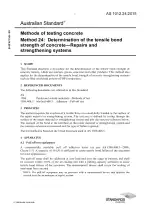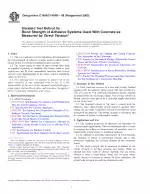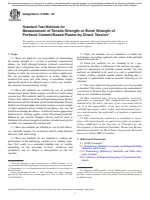ASTM C1583/C1583M-20 PDF Download
Standard ENStandard Test Method for Tensile Strength of Concrete Surfaces and the Bond Strength or Tensile Strength of Concrete Repair and Overlay Materials by Direct Tension (Pull-off Method)
Also Known As:
ASTM C1583/C1583M-20 is a standard test method that is used to determine the tensile strength of concrete surfaces and the bond strength or tensile strength of concrete repair and overlay materials through the direct tension (pull-off) method. The purpose of this test is to assess the adequacy of surface preparation before the application of repair or overlay materials, evaluate the bond strength between the repair material and the substrate, and measure the tensile strength of the repair or overlay material itself.
To conduct this test, various apparatus are required, including a core drill, core barrel, steel disk, tensile loading device, and a coupling device. The test is performed either on the prepared surface of the concrete base before applying the repair or overlay material or on the surface of the material after it has been applied. A shallow core is drilled into the substrate, and a steel disk is bonded to the top surface of the test specimen. A tensile load is then applied to the steel disk until failure occurs. The failure load and mode are recorded, and the nominal tensile stress at failure is calculated.
The standard also emphasizes that the test method is applicable to both field and laboratory use. It can be used to determine the near-surface tensile strength of the substrate, which serves as an indicator of surface preparation quality before applying repair or overlay materials. Additionally, it can evaluate the bond strength between the repair or overlay material and the substrate, as well as measure the tensile strength of the repair or overlay material. The method can also be employed to evaluate the adhesive strength of bonding agents. It is important to note that the test may measure either the bond strength or the tensile strength of the material, depending on the failure mechanism that requires the least stress. Therefore, the failure mode should be reported for each test result, and averaging is only done if the same failure mode occurs.
| Descriptors | repair, overlays,Concrete,Bond Strength,Direct Tension Test,InstallationCOMMA Maintenance and Repair,Tensile Strength |
| ICS Codes | 91.080.40 - Concrete structures |
| Language(s) | English |
| File Size | 307.2 KB |

